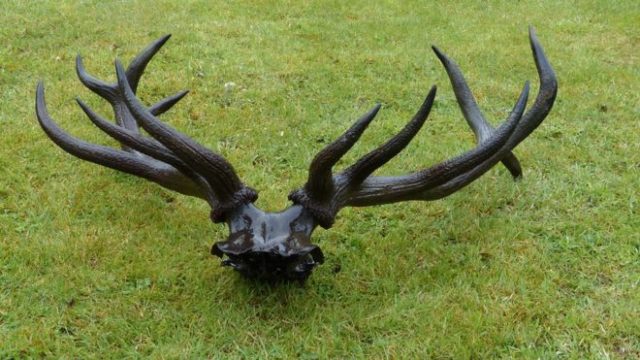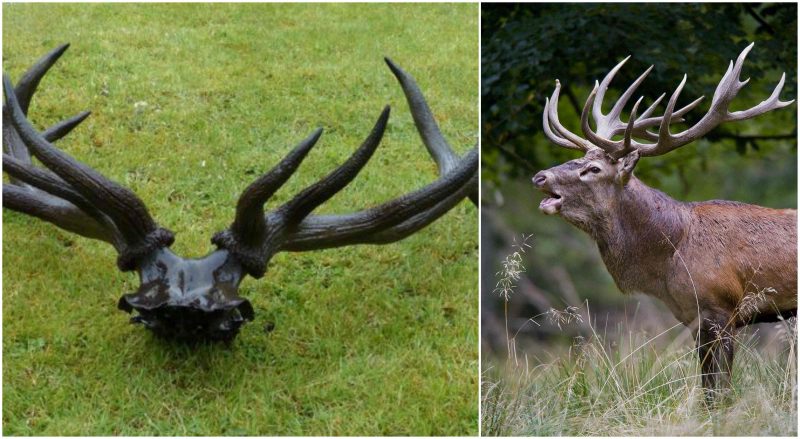Ever wonder what the world looked like thousands of years ago? Just think: deserts used to be rich with green, and some bodies of water didn’t exist or perhaps they were even bigger than what we know today.
About two years ago, a couple walking on a beach in Wales stumbled across a deer skull. They had it tested because it appeared much larger than a regular deer; it turns out that the skull was of a red deer and was dated as 4,000 years old.
The beach the couple found the skull and antlers on had once been an ancient forest and is now filled with water. The forest had been uncovered by storms, resulting in beach walkers finding some amazing ancient features. The skull was found lying in the sand at a beach in Borth, Ceredigion, Mid-Wales. This area in particular has given many archaeologists secrets from the past to examine.

After further analysis, the antlers measured out to be about four feet wide. They are believed to have belonged to a giant stag which roamed that forest during the Bronze Age. Over time, the forest became bare after strong tides pushed their way onto the Cardigan Bay coastline. Back in 2014, storms once again revealed oak stumps that were about shin-high, along with yew trees and other treasures. Peat had also been found in the area before it was washed away by the rain and waves from the shore.
As the two walkers made their way down the beach, they found something cutting through a channel at the site of where the fossil forest used to be. These were the antlers of the adult, large red deer covered by the incoming tide. Thankfully, scientists were able to discover their exact location as photos were taken at the time of discovery. The experts were then able to lift the antlers carefully from the seabed where they had been covered by a few inches of water.
The antlers are still being studied by an archaeological research team at the University of Wales-Trinity St. David’s in Lampeter. The lead archaeologist, Dr. Martin Bates, said that this is a wonderful discovery. It helps the researchers see what kind of wildlife lived there and the makeup of the area that had been rich forest before being covered with water.
After examining the peat, Bates said that it dates to about 6,000 to 4,000 years ago. This would have been right around the time the last hunter-gatherers were in the area, as well as the earliest farmers in Britain. Bates expressed that he was happy when the find was identified instead of being left unreported or taken as a beach prize. This allows the researchers to study the remains, instead of the items sitting in someone’s home and lost to the entire world.
Dr. Ros Coard, the university’s faunal specialist, said that the animal was most likely at the prime of its life; she knows this because the antlers were fully-developed before the animal died. The peat and the antlers will form the basis for an investigation of the area. The researchers are going to try to figure out how and why the animal died centuries ago.
The stumps too were once part of a forest that had actually covered the whole area; first the forest turned into a peat bog and eventually it was all finally covered over by water. The most interesting thing is that the peat and skull were well preserved, most likely due to the peat bog. Peat, especially, is deprived of oxygen, resulting in a higher alkaline level. This lack of oxygen means microbes which cause decay can’t grow; in effect the alkali pickles everything it touches and helps preserve what’s around it.

There’s an ancient folk tale about Cantre’r Gwaelod, or the Sunken Hundred, which was once a fertile land and township before it was lost beneath waves. It is believed that the land extended nearly 20 miles west of Cardigan Bay, but Cantre’r Gwaelod was lost to floods when, apparently, Mererid, the priestess of a fairy well had neglected her duties, resulting in the well overflowing.
Before the skull was found archaeologists thought that only the stumps were there under the water. The 5,000-year-old trees are only visible at low parts of the tide. The storm in early 2014 had revealed something completely new for archaeologists – a whole new section that included oak and pine near Ynyslas, which is further north than the last remains discovered. Those stumps, like the others, are preserved because of the peat.
It is thought that part of a wattle walkway, which also dates to ancient times, has also made an appearance. Made from branches, sticks, or logs, it would have allowed people to cross the wet ground without sinking into it.
The discoveries of the stumps were made by Deanna Grooms and Ross Cook from the Royal Commission on the Ancient and Historical Monuments of Wales. Grooms, a maritime archaeologist, said that the site around Borth is where the shore gets hit constantly by bad storms, resulting in its having been battered numerous times. Because of that there was a good chance something would eventually be uncovered. She added that there are areas that are regularly monitored for this purpose, in case something washes up or emerges from the sand.
